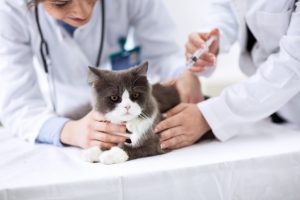
Canine parvovirus (also known as parvo) is a highly contagious viral infection that can be lethal in puppies and dogs. It is spread by any animal or anything that comes into touch with the feces of an infected dog. Unvaccinated puppies, adolescent dogs, and adult dogs are in danger of catching the virus. Protecting your puppy or dog against parvovirus could mean the difference between life and death.
Parvovirus Symptoms
Parvovirus symptoms include lethargy, loss of appetite, abdominal discomfort and bloating fever or low body temperature, vomiting, and severe, often bloody diarrhea. Consistent vomiting and diarrhea can cause dehydration, and intestinal and immune system damage can lead to septic shock.
If your dog develops these symptoms, you should contact your veterinarian. The majority of deaths here occur within 48 to 72 hours of the onset of clinical symptoms.
Diagnosis and Therapy
Parvovirus infection is usually suspected based on the dog’s history, physical examination, and laboratory tests. Fecal testing may be required to confirm the diagnosis. There is no specific medication available to remove the virus from infected dogs. Treatment is intended to reinforce the dog’s body systems until the dog’s immune system can combat the viral infection.
Treatment should begin as soon as possible, focusing on rehydrating the patient by replenishing electrolytes, protein, and fluid losses, controlling vomiting and diarrhea, and preventing secondary illnesses. Sick canines must be kept warm and receive good nursing care. When a dog acquires parvovirus, treatment can be prohibitively expensive, and the dog may die despite aggressive treatment. Early detection and aggressive treatment are critical for a positive outcome. With proper care, survival rates can reach 90 percent.
Because parvovirus is very contagious, it is critical to isolate sick dogs to prevent infection spread. Cleaning and sanitizing polluted kennels and other facilities where infected dogs are (or have been) appropriately housed. Because the virus is difficult to remove, consult with wellesley veterinarians for particular cleaning and disinfection product suggestions.
Parvovirus Prevention
Vaccination and sanitation are important preventative strategies.
Young puppies are especially vulnerable to infection because the natural immunity produced by their mothers’ milk may wear off before the puppies’ immune systems mature sufficiently to battle infection. If a puppy is exposed to canine parvovirus during this period of weakened protection, it may get the illness.
Furthermore, the protection supplied by mother’s milk may hinder a successful vaccination response. This means that even completely vaccinated puppies can get parvovirus and become ill occasionally. A series of puppy vaccinations are administered throughout the first few months of life to bridge protection gaps and protect against parvovirus. Puppies should be vaccinated against canine parvovirus from 14 to 16 weeks, regardless of previous immunizations.
Pet owners should ensure that their dog’s parvovirus immunization is up to date to protect their adult dogs from parvovirus infection. While titers are available to identify a dog’s level of antibodies against canine parvovirus, the antibody level does not necessarily translate into protection when the dog is exposed to the virus. Consult your veterinarian about a preventative regimen that is appropriate for your dog plus you also get the chance to opt for Routine pet dental care.
Conclusion
The word “parvo,” which stands for parvovirus, is enough to send shivers down your spine. This highly contagious virus is notorious for fast converting a previously healthy puppy who was showering you with stinking puppy breath kisses and playing one day into an almost or fatally ill dog in a matter of days. Fortunately, this disease in dogs is preventable and treatable if detected early.









